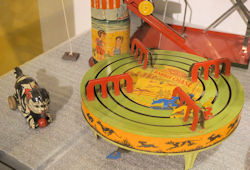
The 1910s witnessed the debut of three of the most popular toys of the twentieth century – Erector Sets, Tinkertoys, and Lincoln Logs. Each were also engineering and construction toys inspired by real world observation.
Alfred Carlton Gilford, for instance, came up with the idea for Erector Sets while watching steel girders being installed during a train ride from Connecticut to New York. Construction of the Imperial Hotel in Tokyo led John Lloyd Wright to conceive Lincoln Logs, and Charles H. Pajeau was inspired to create Tinkertoys after seeing a group of kids using sticks and empty spool threads as building blocks.
Although not a construction toy per say, the likewise popular Sandy Andy used the real world for inspiration as well. Sand could be poured into the red hopper at the top of the mechanical device while a pulley was used to maneuver a yellow sand cart upward on an attached slide. When the sand was then released into the cart, the cart would travel back down the slide and dump the sand.
Sandy Andy was developed by the Sand Toy Company of Pittsburgh, Pennsylvania, which contracted with the Wolverine Supply & Manufacturing Company for construction of the metal parts. When the Sand Toy Company later went into bankruptcy, Wolverine gained the patents for Sandy Andy and began producing the toy themselves in 1909.
Sandy Andy was an immediate success within the toy industry, and Wolverine founder Benjamin Franklin Bain soon shifted his company’s focus from household appliances to the full-time manufacturing of toys. Originally located in downtown Pittsburgh near Penn Avenue, Wolverine Supply & Manufacturing moved to the North Side in 1913, where it remained until 1971.
During its heyday, Wolverine produced mechanical toys that reflected the popularity of construction toys while likewise branching into “housekeeping” toys – miniaturized versions of refrigerators, stoves, and washing machines. The company’s success made it one of the top toy manufacturers in the country during the first half of the twentieth century, as well as within the emerging global market that the United States would eventually dominate.
In his 2013 book Wolverine Mechanical Toys and the Story of the Wolverine Supply & Manufacturing Company, Terry Morrow offers a meticulous history of Wolverine along with an addendum filled with pictures and information about the various toys designed by the company. Taken as a whole, Morrow’s text is a historical document of not only Wolverine Mechanical Toys but the short time period when Pittsburgh played a leading role in the growing industry.
Benjamin Bain graduated from Michigan Agricultural College – known today as Michigan State University – in 1893 with a degree in engineering. He slowly made his way eastward before permanently taking up residence in Pittsburgh and establishing the Wolverine Supply & Manufacturing Company in 1903.
Sandy Andy was originally marketed to large department stores throughout the United States. James Lehren, an immigrant from Holland, was hired part-time in 1914 as a demonstrator for Sandy Andy at Gimbels Department Store in New York City. Lehren excelled in the position, and Benjamin Bain soon hired him full-time as the company’s sole salesman.
“From the beginning, Bain’s design mantra was to provide toys for young boys stimulated by the industrial and construction sights around them, so the expansion of the Sandy Andy features to include additional motions led to the Sand Crane and Dumping Crane,” Morrow explains. “All the while that Bain was working on his sand toy concept, it appears that he was inspired onto a related concept of his own. The toy, the Sky-Scraper Elevator, was powered not by sand but by discharging large steel marbles.”
In 1914, the United States completed construction of the Panama Canal, and the engineering feat led to the Panama Pile Driver from Wolverine. Like the Sky-Scraper Elevator, the toy used marbles instead of sand to drop a pile-driving hammer, which then operated in much the same way as the actual equipment used in Panama.
Around the same time that the Pile Driver was launched, Wolverine introduced the Cyclone Windmill Pump, which was initially operated by either hand or wind power before a small electric motor was added a few years later. Regardless of the power source, sand was able to flow through the toy in much the same way as a water pump.
At the 1918 New York Toy Fair, Wolverine announced a new “Sunny Suzy” line of toys for girls, including a “Laundry Set” that contained a washboard, wash line, tin tub, and clothes pins. Tea sets and coffee dishes soon followed, along with irons and ironing boards. In 1925, the company even developed the first fully-functioning toy vacuum cleaner.
As the decades rolled along, so did the scope of the toys created by the renamed Wolverine Toy Company. Pull-along trains, horseshoes, board games, military toys, sand buckets, and games similar to those found at circuses, fairs, and carnivals were all manufactured by Wolverine.
The growing popularity of baseball in the United States led to the development of board games by a variety of toy companies. None of them effectively replicated an actual baseball game, however, until 1929 when Wolverine began producing a mechanical version invented by Pittsburgh residents Alexander Weinberg and C.V. Linderman.
“With its large green tin playing field surrounded by a thin wooden wall, the game had nine tiny blue cast iron players on the field and three red players to bat and run the bases,” Terry Morrow explains in Wolverine Mechanical Toys. “The game was designed for two players, one controlled the pitches, which were spring-powered in two speeds, and the other controlled the spring-powered bat. The field appears to have just the right combination of pockets and deflective plates to guide the game’s outcome to those expected in a real game.”
New educational toys from competitors in the 1940s and 50s – coupled with a switch to plastic as opposed to the steel designs of the Wolverine Toy Company – led to declining sales for Wolverine during the second of half of the twentieth century. Unable to compete in the emerging new market, the company became a subsidiary of Sprang & Company in 1968, with operations permanently moving from Pittsburgh to Booneville, Arkansas, in 1971.
The Wolverine Supply & Manufacturing Company may no longer exist but its legacy lives on nonetheless. When Sandy Andy first appeared in 1909, the United States was just a footnote in the global toy industry but would soon become the undisputed leader. The toys manufactured by Wolverine were just as instrumental in that transformation as the Erector Sets, Lincoln Logs, and Tinkertoys produced by better known companies.
Pittsburgh played a major role in a number of industries through the centuries, from steel and glass to ketchup and robots – and thanks to the Wolverine Supply & Manufacturing Company, mechanical toys are a part of the city’s impressive legacy as well.
Anthony Letizia
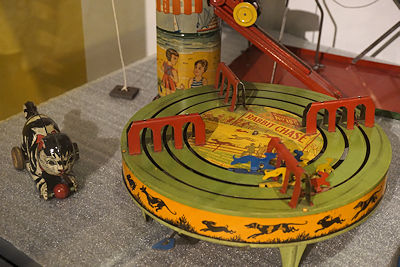
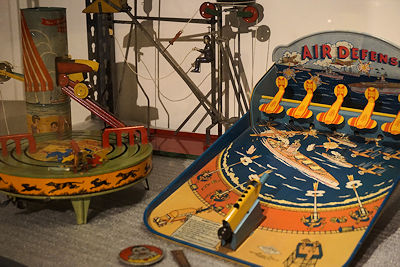
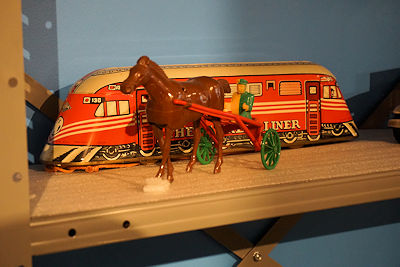
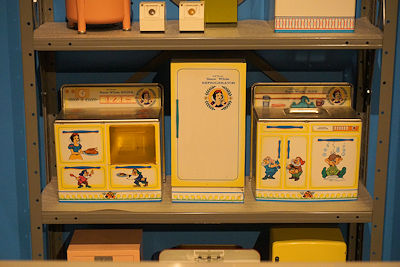
(ABOVE PHOTOS: Assortment of Wolverine toys on display at the Senator John Heinz History Center in Pittsburgh.)

